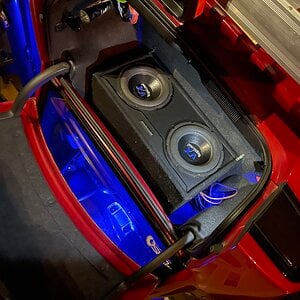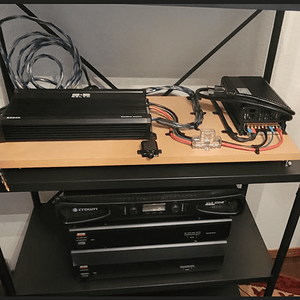quoted from over on SMD. Excellent read on port area.
Port area. what does it affect? - Page 2 - SPL - SOUND PRESSURE LEVEL - SMD Forum
"Minimum port area can be found from a few variables of your system such as cone area in total, xmax and tuning frequency.
Using this:
Calculate the minimum port diameter from the following equations:
Sd = pi*(Dia/100)^2/4
Vd = Sd*Xmax/1000
Dmin = 100*(20.3*(Vd^2/Fb)^0.25)/Np^.5
where,
Dmin = minimum port diameter (cm)
For vented type speakers operated at full power that is, full excursion, it is possible to end up with audible noise from the air rushing in and out of the vent. For a given speaker system, the smaller the vent opening the greater the velocity of air in the vent and the greater the vent noise.
The main reason this ever became a topic is because Richard Small (the S in T/S Parameters) wanted to know the minimum velocity the air from the port could have without causing noise. This happens to be about 5% the speed of sound. That formula should get you close to it, but with modeling software you don't really need to use it, just make sure your port velocity is down.
There are other negatives from port compression such as added heat from inadequate air transaction and poor frequency responses due to it as well.
The Xmax is there to have it know your upper limit of excursion.
If you use less power you'll have less excursion to cause less air to move. So you could use a smaller port area, but when designing you design around your speaker not your amplifier, because what if you get a bigger amp.
If you could have too much port area then playing speakers at low volumes would sound absolutely horrible as the port area needed gets exponentially smaller as you use less power.
Unloading is based on port location not area.
Area can make positioning it hard to keep from unloading happening, but doesn't cause it.
No such thing as too much port area (at least within reason), there is such thing as too long of a port though, and since area and length are tied to tuning, you can definitely get yourself into a spot where your port is too big, because its too long.
Cone control problems will arise from not enough port area, not from too much.
Not having enough port will cause port compression. This makes your box start to act like a leaky sealed box. Output around tuining will drop, impedance will rise, output from your amp will decrease.
If your port is too long you run into trouble with pipe resonance.
Pipe resonances will produce extra harmonic waves and in extreme conditions it can adversely affect your overall output.
I believe I talked with Triticum about this at one point and I think I said that you don't want your vent length longer then 1/4th the length of the frequency you're tuning to.
And also impedance and tuning of your box changes when adding power."


